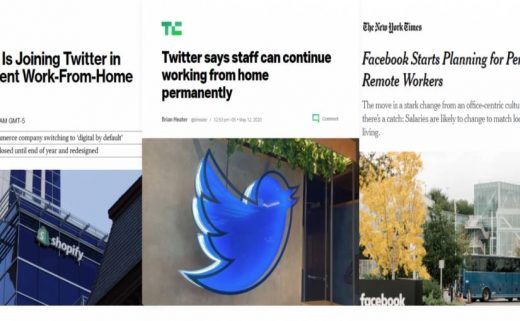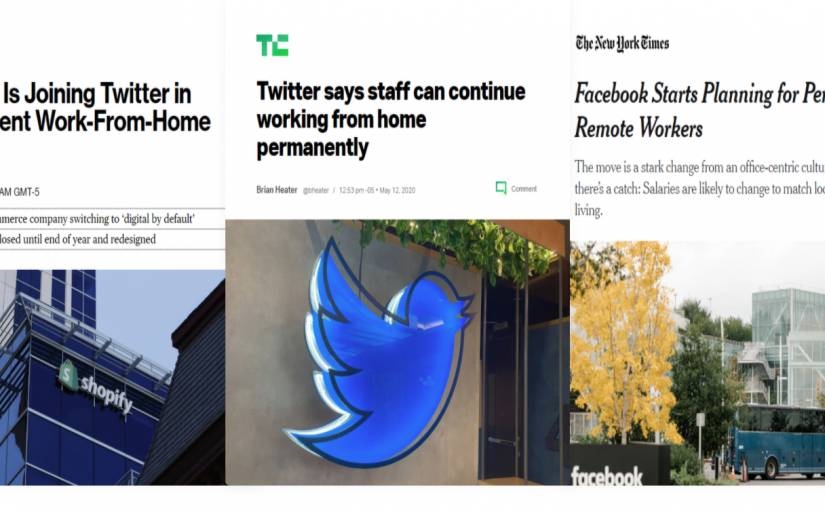Remote Work in the Time of COVID-19
Remote Work in the Time of COVID-19

The world has changed…
Two months ago, if I told you that remote work would be the global norm by mid-April, you’d have thought I was hanging out with Elon Musk too much. And, if I told you that by the beginning of May, you’d make every hire remotely, you might have laughed in my face. Here is remote work in the time of COVID-19.
…suddenly, nearly all technical jobs are remote-jobs, all dev-teams are distributed teams, and virtually all hiring is remote hiring.
In this article we’ll take a quick look at the trends that have accelerated this progression beyond all expectations, we’ll consider what to expect once we’ve made it to the other side of the coronavirus crisis.
And finally, we’ll dig into the fundamental changes in leadership, management, and mindset that will allow people to weather this period of extraordinary change and come out the better for it.
The shift to remote work has radically accelerated.
Fully remote distributed companies used to be a rarity. Now, it’s the new normal. As a result of COVID-19 and the sudden need for social distancing, everyone is working from home. In an instant, remote work went from a small Silicon Valley trend to a ubiquitous element of daily life. Zoom, Slack, Trello, Jira, and Microsoft teams – are all suddenly household names.
You can’t read the news or watch TV without seeing a how-to-go-remote guide.
What’s fascinating is that this global experiment in remote work has been a surprising success. Sure, there have been a few hiccups, a few cats (or kids) in the frame during the nightly news, and one or two things that were shared with co-workers unintentionally.
What we’re not hearing is businesses blaming their problems on the fact that people are working from home.

Why remote work will persist after the disease dies out
Coronavirus may have accelerated this change, but it isn’t this crisis that will cause the change to stick. That’s because remote work is more than just concerns about health and social distancing. Driving this tectonic shift in the way we work, the way we hire, and who we’ll be hiring (and working with) in the future — is something else.
The perspective of running a company that specializes.
From my perspective, as someone that runs a company specializing in hiring high-quality remote engineers, matching people with opportunities, and managing remote teams, there are three key drivers.
The Coronavirus pandemic is undoubtedly a catalyst for this sudden movement, but the underlying factors that are powering this change include:
- Employee preference to work from home (plus higher productivity in many cases)
- Cost savings companies experience when they eliminate expensive office rents and the payroll costs associated with the salaries required for people to live in major metro areas.
- The fact that the Internet and remote work apps are finally fast and robust enough that near-seamless remote collaboration is possible.
Many people are more productive working from home
During this sudden office-exodus, where every company has had no choice but to become boundaryless, my long-held conviction that remote-work works are being borne out by new data. A recent study by YouGov that surveyed 10,000 people working from home found that productivity increased. From the USA Today Article:
“So perhaps it’s not exactly shocking to learn that working from home during the COVID-19 pandemic has had a positive effect on workers’ productivity, according to 54% of respondents in a recent survey of professionals ages 18-74.
The reasons for this, they said, were time saved from commuting (71%), fewer distractions from co-workers (61%), and fewer meetings (39%).”
People have discovered that working from home works for many of us. It turns out that we like skipping a hectic commute, living in an affordable community, the reduced need for childcare, and the chance to spend more of our days with our families.
CFOs expect the trend will continue since it saves companies money
Another driver of this shift is financial. In today’s economic climate, which very likely reflects a severe recession, companies need to prioritize efficiency ruthlessly. If eliminating big office rents and the costs associated with operating in major metropolitan areas don’t equate to a significant loss in performance, why should a company spend the money? If your people can deliver from the comfort of their kitchen table, why make them commute, ride crowded elevators, or share space with other people?
Supporting this trend is a recent Gartner survey that revealed that:
74 percent of CFOs expect some of their employees who worked from home because of the COVID-19 will continue working remotely after the pandemic ends.
The technology is mature enough that working from home works pretty well
Ten years ago, having the whole world exit offices and connect from home would have yielded a very different result. The internet itself, and most particularly last-mile connectivity, would not have supported the sudden global shift. Who knew our current infrastructure could support several billion people suddenly streaming video, sharing screens, and running multiple connected applications, let alone also homeschooling their kids, and playing in VR worlds.
Even in developing countries, fast connections are now common enough that almost anyone that needs a fast internet port has access to one. And the applications that support all this working from home have made a quantum leap too.
There are already half a dozen enterprise-grade video communication applications in our Boundaryless Landscape. And even more collaboration, asynchronous communication, and project management tools for all kinds of work, and a world that is ready to embrace a workforce that works from home.
After the crisis
My crystal ball isn’t any better than anyone else’s when it comes to seeing how this pandemic ends, nor how long it will massively impact daily life. But my vision is clearer when it comes to how companies are going to look when we arrive at our post-COVID normal.
I think many companies will be leaner. The survivors will be the ones that are particularly effective at cutting unnecessary expenses, adding or maintaining talent, or identifying new niches. All of them will include managers that are skilled at managing remote people and teams.
I expect that we’ll see far fewer corporate headquarters with thousands of people working on-site, with many companies maintaining smaller offices along with a large number of semi or permanently remote personnel. On this, I’m not alone; Mondelez, Nationwide, and Barclays all expect many positions to become permanently-remote.
I think big tech hubs like silicon valley will still be highly relevant for securing capital, and for bleeding-edge ideas. Still, my bet is that the next generation of successes may be bred in San Francisco, but they will be born around the globe.
In other words, I think that the post-coronavirus world will be flatter than the one we just left behind.
Managing to Win
There are already a ton of great resources online for helping companies get a handle on running a remote operation. There’s a nice synthesis of them here. If you need to choose better tools or want a primer on communication best practices for remote teams, there’s no shortage of options. But what I haven’t seen are any articles that talk about the company-wide processes that you must build and maintain to achieve success with a company that no longer has walls.
I thought it might be helpful for people to learn about the process I have found to work best for managing and scaling a distributed engineering team – this is how we run Turing.
Firstly, you need a clear plan for your company. And second, you need to communicate that plan with all the stakeholders in your business.
If you’re the CEO of the company that’s your executive team, whether it’s engineering, product sales, marketing, social media, and all these other functions, you need to have feedback loops, with checkpoints to track how well you’re executing relative to that plan.
For example, we establish a plan for a month. Then we set monthly OKRs. We have weekly executive reviews of those OKRs to track how we are progressing against intermediate milestones relative to the ultimate monthly goal. In the old days, this might happen in a meeting in someone’s office or in a conference room where you’d come up with a plan and build those checkpoints.
Now, for a company like Turing, we create a plan like that, but it’s in a Google spreadsheet or some other format communicated widely across the company. Then, we have these weekly check-ins to see how we’re doing relative to plan and to make periodic course corrections. If we have to reprioritize something, or we see something is not going as planned, we can determine what to do.
We used to make these adjustments synchronously through a lot of meetings and a lot of face to face communication. Now, we’re doing this using Google Sheets and video conferences, and other asynchronous forms of communication. I find it highly efficient to share a spreadsheet with all the people in a company so that everyone can see what our priorities are at any point in time.
One can argue that this way of working is better than the old way. Prior methods tend to create knowledge silos in an organization where people who were not in the room may not know what the company’s prioritizations are. Now everybody does. That’s the more efficient way to do it.
What’s particularly important at this time, is also to make sure that the leadership team in the company is present, and over-communicates with everyone on the team. Whether it’s reassuring the team about the short-term and long-term future of the company, staying positive, and making sure you substitute for all the social connections that would have otherwise happened in an office.
At Turing, we do that with our boundaryless lunches, with our weekly thank-yous where we tag people in the team for their contributions, and we do a virtual happy hour now, too, where people get together and connect over a video conference.
Companies Must Build a Process for Managing Distributed Engineering Teams
To put a finer point on it, I use the following specific framework to help lead my leaders and their teams.
The “CAPE” framework consists of
C – Communication. You must be brutally realistic about what’s happening in the market today, good or bad, with yourself, your team, and your investors. Because if you’re not communicating the reality the right way, then everyone can’t be aligned on the same plan.
A – Alignment. Make sure everyone is aligned on the right priorities, that you’ve communicated those priorities, that everyone understands them, and that the whole team shares a consistent view of what needs to be done.
P – Prioritization. During times of crisis, you need ruthless prioritization where you don’t focus on things that don’t create immediate business value. You must focus on growing revenues, predicting revenues, and reducing expenses. You should not be doing things that will deliver value 12 months from now.
E – Execution. Have clear goals and targets that you track with high-fidelity. By high-fidelity, I mean high frequency. Now is not the time to have quarterly targets. Especially during challenging times, you need to have a monthly target and track it weekly to see how you’re tracking relative to that so that you can course-correct quickly.
If you apply the general concepts of the CAPE framework in the context of a fully distributed team, you’ll achieve a much higher level of efficiency throughout your organization; people will be more certain of what’s happening, and what needs to be done next. Short cycles with small corrections can yield easy wins that add up to a company that succeeds.
One small silver lining
“That which does not kill us makes us stronger.” Nietzsche
Not every business is going to survive this massive shift in our economy. But the ones that do make it will come out the better for it. The good habits that these teams have developed, management’s skill at running distributed teams, and the ability to execute under pressure will create a generation of antifragile companies poised to grow when conditions allow it.
A Quick Word About Hiring in the Time of COVID-19
If your company is in the fortunate position to be expanding during this time, you’ll find yourself awash in talent, especially when you’re able to recruit from anywhere on earth. Furthermore, as part of the ruthless economic triage, you’re likely to be doing, finding skilled engineers in geo-arbitrage regions is probably more attractive than ever before. But how can you go about hiring engineers in an age when a face to face interview can kill you? The answer is obvious. Remotely.
All Hiring is Remote Hiring
Touchless hiring. It sounds simple. But many things sound simple, not all of them are. It’s easy enough to imagine sorting through resumes, maybe checking a reference, and setting up interviews over the internet with your favored candidates.
To be fair, a lot of companies do hire people like that, but this method doesn’t scale. It takes an unreasonable amount of time to identify the best candidates, and a substantial percentage of your hires will likely fail in their new roles.
Hiring Challenges
These challenges are particularly serious if you want your hiring net to consider talent from all over the globe. While people can (and do) rely on recruiters for help, how do you find a recruiter that can operate without meeting candidates before passing them along to you?
Recruiters and Resumes
And how do you or a recruiter know if a resume is good? It’s easy to vet Silicon Valley hires. You know Stanford is a great school. But what’s the Stanford of Kosovo? Or the Harvard of Brazil? We don’t know.
US resumes are likewise simpler to evaluate. If someone worked at Google, or Facebook, or Apple, or a highly regarded venture-funded startup, you can be reasonably certain that the person is skilled. You can also be reasonably sure that they have advanced English communication skills.
But you can’t assume that these things are true if an applicant is from Hungary. They may be a top-tier engineer or not. They may be an excellent communicator with well-developed remote working skills, or not. Tons of talented people live in Africa, but can you name even a single African company, much less be able to vet the resume of a Nigerian applicant?
What Solves the Problems?
Globally, finding the best candidate may appear to be a big problem — and throwing more people at it won’t solve it. An army of recruiters would still fail to find and adequately vet the top 1% of job-seeking engineering talent from every continent.
How to Find the Best
Even today, during the COVID-19 pandemic, when millions of newly jobless people are actively searching for opportunities, getting to the best of them is a job better suited for AI than humans. After all – how many resumes can you read in an hour? How many hours do you have to spend reading CVs?
The point is, that if you’re in the fortunate position of needing to add headcount, you’d be well-served to consider one of a number of the work-from-home platforms that undertake the task of sourcing and (in some cases also) vetting the talent.
Conclusion
Companies in this space include my company, Turing, as well as Andela, UpWork, Fiverr, Dribble, and others. Global talent like these platforms too. My experience running a company that sources talent is that more highly skilled people are joining our platform every month. April was the biggest month in Turing’s history, and May is looking likely to be bigger still.
Image Credit: Matilda Wormwood; Pexels
The post Remote Work in the Time of COVID-19 appeared first on ReadWrite.
(58)



